.: Got GOUT? The 2006 Original Version DVD Bonus Feature Fiasco
Some people might argue: "What are you complaining about? Weren't the original versions of the films released on DVD in 2006?" This is true. You might also have noticed how poorly the films look. "That's because they are old, unrestored films, the original versions with all their defects." Right? Not by a long shot. The original, unaltered films on the DVD look poor because the transfer was done in the early 1990s for Laserdisc, and was hopelessly outdated by the home video standards of 2006. Given that these original versions were presented as bonus materials, maybe this low quality is understandable, but that's the problem in the first place. I'll get into the issues surrounding this release and examples of the telecine problems in a bit, but here is some background about how the 2006 DVDs came to be.
After George Lucas swore that the original versions of the Star Wars trilogy would never be seen again, about half the film world cried out in terror, much like denizens of Alderaan as their world literally exploded. Lucas, however, maintained that it was his "vision" that the films remain as their Special Edition incarnations, and that the originals not only were "half complete" but that they didn't exist for him anymore. After protests and criticism, people began transferring their Laserdiscs to DVD, and a gigantic bootleg circuit opened up. Originaltrilogy.com had petitioned 70,000 signatures to get the original versions released, and as pressure mounted on Lucasfilm, eBay and street bootleggers were swamped with dozens of different kinds of unofficial DVDs of the films. Behind the scenes, it was rumoured that Lucasfilm VP Jim Ward desperately wanted to have the original versions released, even as the 2004 DVD boxset contained the Special Editions only, but Lucas maintained that there was only one version of the films he wanted people to have access to. "The other version, it's on VHS if anybody wants it," he said in a 2004 interview. "I'm not going to spend the, we're talking millions of dollars here, the money and the time to refurbish that, because to me, it doesn't really exist anymore. It's like this is the movie I wanted it to be, and I'm sorry you saw half a completed film and fell in love with it." As you can imagine, this ticked a lot of people off even more.
Then, In 2006, Lucasfilm finally broke. It was announced on May 3rd on the Star Wars website that the original versions of the films would be coming to DVD that September:
"In response to overwhelming demand, Lucasfilm Ltd. and Twentieth Century Fox Home Entertainment will release attractively priced individual two-disc releases of Star Wars, The Empire Strikes Back and Return of the Jedi. Each release includes the 2004 digitally remastered version of the movie and, as bonus material, the theatrical edition of the film. That means you'll be able to enjoy Star Wars as it first appeared in 1977, Empire in 1980, and Jedi in 1983. See the title crawl to Star Wars before it was known as Episode IV; see the pioneering, if dated, motion control model work on the attack on the Death Star; groove to Lapti Nek or the Ewok Celebration song like you did when you were a kid; and yes, see Han Solo shoot first. This release will only be available for a limited time: from September 12th to December 31st. 'Over the years, a truly countless number of fans have told us that they would love to see and own the original version that they remember experiencing in theaters,' said Jim Ward, President of LucasArts and Senior Vice President of Lucasfilm Ltd. 'We returned to the Lucasfilm Archives to search exhaustively for source material that could be presented on DVD. This is something that we're very excited to be able to give to fans in response to their continuing enthusiasm for Star Wars.' "
All at once, the internet burst out into wild elation and jubilant celebration. The mass media began running stories on it, from MTV to USA today. Then, Lucasfilm VP Jim Ward started saying something fishy about 1993 being the source for these. "It is state of the art, as of 1993, and that's not as good as state of the art 2006," he said in an article for USA Today on May 4th. Websites swore that there was no way he could be implying that these were the 1993 Laserdisc sources; that was just paranoia. There was no way that in 2006 a company would put out a thirteen-year-old non-anamorphic Laserdisc master for such momentous films and with such media focus on the release. There was no way Lucasfilm could be that callous and show that much disrespect for such classics. Lucasfilm later confirmed the horrible truth that this was so, and that the originals were furthermore merely bonus features in another Special Edition release. Home theatre enthusiasts could hardly believe their eyes. After a massive load of angry letters reached Lucasfilm, publicist Lynn Hale issued a general statement which read in part:
"As you may know, an enormous amount of effort was put into digitally restoring the negatives for the Special Editions...The negatives of the movies were permanently altered for the creation of the Special Editions, and existing prints of the first versions are in poor condition. So many fans have requested the original movies, we wanted to find a way to bring them to you. But since these movies do not represent George's artistic vision, we could not put the extraordinary time and resources into this project as we did with the Special Editions. The 1993 Laserdisc masters represented the best source for providing the original versions as DVD bonus material."
Is this true? Preeminant home theatre website Digital Bits followed the fiasco and was very vocally critical about it. They were especially upset when they confirmed the releases were not even treated to anamorphic enhancement. Their own Robert Harris, the guy who hand-restored Lawrence of Arabia and Vertigo, said that he knew it was not true that the 1993 master was the best source, and knew that there were 35mm elements available, and he and the Bits offered to obtain 35mm material for a new transfer. This began a lot of debate about the original negative. Did it exist? Was George Lucas being literal when he said it no longer existed? Was it destroyed, along with all copies? They couldn't have done that...could they have? Even in the 2010 documentary The People Versus George Lucas, no one seems to really know.
Well, as I've written on the site before, Lucas is being technically accurate, but misleading. The negative is conformed to the Special Edition edit, because there can only be one original negative. So, technically speaking, the negative assembly of the originals does not exist. But it would be very easy to simply put the original pieces back in and conform it to the original versions. Actually, in a theoretical modern restoration, they would just scan the original pieces and make a digital edit, especially since disassembling the negative puts a lot of wear on it. There are also secondary sources, such as separation masters and interpositives, both of which were used to make duplicate pieces to repair parts of the original negative for the 1997 release. So, basically, the official Lucasfilm stance is a lot of crap, designed to confuse people who don't have a thorough knowledge of how post-production works.
What the publicist said is also technically correct, but misleading. The last time a new transfer was done of the originals was 1993, which was also re-released in 1995. There are ample 35mm materials available to do a new transfer, but the most recent pre-existing version is from 1993, ergo this is the best version Lucasfilm had access to without having to re-transfer the films fresh. Again, if one did not fully have knowledge of the home video history of Star Wars, this might seem to imply that this is the best version of the films that is ever going to be possible.
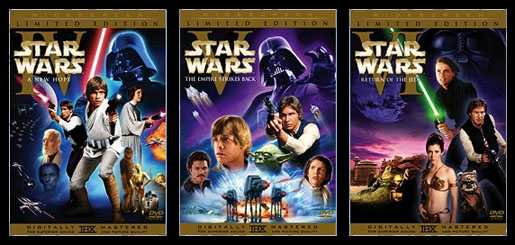
So, in September of 2006, the DVDs hit shelves. While being technical "bonus features", you sure wouldn't know it from the way the release was advertised, with giant cardboard store standups touting the original theatrical versions being included. There was even a commercial for the DVDs, showing the original crawl and everything. Lucas was interviewed by MTV for the release, where he stated: "It's just the original versions, as they were. We didn't do anything to it at all. But we're not sure how many people want that...Now we'll find out whether they really wanted the original or whether they wanted the improved versions. It'll all come out in the end."
Of course, gone was his pretentious statements about his vision. It seems these versions do exist to him after all. It marked a severe injury to Lucas' crusade; his personal integrity about artistic intent had imploded. And if it was about stopping bootleggers from pirating the original versions, as some theorized, then it shows that not only does he still acknowledge these versions, it also shows that making money is really the bottom line when it comes to this franchise and the integrity of his "vision."
However, fans had a sneaking suspicion about the reasons for the quality of the release. It borders on paranoia, but there seems to be lots of truth in it. On originaltrilogy.com, the release was coined the GOUT--George's, Original, Unaltered Theatrical versions.
That is, Lucas deliberately wanted the original versions to be presented in an inferior format so that they would not have to compete with the Special Editions. First, while bootlegs were sourced from Laserdiscs, to outcompete them all one would have to do is make an official transfer from the Laserdisc master--the result would be just a bit better than the bootlegs, which would be enough to put them out of commission. In other words, the least amount of quality possible to still have this as the "best available version." A high quality new transfer is unwanted because it also makes the Special Edition not look as good, so all you have to do is pull that 1993 master tape out of a dust bin in the Lucasfilm archives and you've accomplished your mission of not letting people really enjoy watching the originals; they look rough, crude, the way Lucas wants us to think they look.
Probably this was done because Lucas maintained that if the originals were to be included then they were to not spend any money on a new transfer but instead use the pre-existing material. Possibly because of this, or possibly at Lucas' urging that these not be the focus of the release, Lucasfilm was relegated to marketing the transfers as technical "bonus material". Given all of this, it also seemed like a set-up: as Lucas said, "now we'll find out whether they really wanted the original," yet anyone who would have been seriously interested in a release of the films was likely to stay away and save their money, which Lucas could then point out as indicating that no one wanted the original versions after all, in a circular self-fulfilling prophecy.
The release was also touted as "limited time" availability to lure in customers, with the press release stating they would be pulled in December of 2006, but the films have been continually sold until the time of this writing, which is late 2010. How did the release do, anyway? There are no official numbers, but internet rumours started maintaining the release was not a huge success. Actually, from what I could tell, it was pretty successful, especially considering that it was something that should have never been sold in the first place. When it first became available it was in the top purchases of amazon.com, and given its modest marketing budget and the length of time it has been on sale, it must have sold millions of copies by now.
I should also point out, making a new transfer from a 35mm source is not expensive. It literally costs thousands of dollars, which is why stuff like Revenge of the Nerds 2 are presented in modern, anamorphic transfers from 35mm material. Lucas has convinced some people that one would have to totally restore the films for them to look good and spend millions of dollars, but they would still look acceptable if taken from existing prints and materials, and certainly many times better than a master made in 1993. As I have written in other articles for this page (most recently here), Fox restored the negatives in 1995-1997, and almost all of the work is already done. But of course, given that Lucas is a billionaire, this is a moot point, isn't it? Which is why his using this 1993 master is likely a deliberate attempt to create an unfair advantage for his Special Edition.
A final detail might be: what is this master anyway? In 1985, new Interpositive (IP) prints were made for the purposes of home video telecines. In 1993, these were telecined to a Sony D1 or D2 digital cassette tape, probably by means of a 1/3" CCD telecine. These tapes were then used as the sources to make Laserdisc pressings and VHS dubs for that year's releases.
Okay, so I have ranted about how bad the films look, but what am I actually referring to? As a telecine made in 1993, the master is pretty decent, and if you have a smaller 4x3 television that does not make the lack of detail obvious the films are watchable. And, to give Lucasfilm credit, they did include the original 1977 crawl for Star Wars, without Episode IV; which is weird that they would take the time to edit that in, but I guess they had to in order to market it as the "original theatrical version." It also makes me wonder where they got that from, because it looks in great condition, and appears to be a recent transfer; this is probably how the rest of the film would have looked in a new transfer from 35mm elements. However, for anyone that wants to sit back and actually enjoy and appreciate the originals, not just have a copy on disc, the release has a multitude of serious problems.
1) The issue most vocally touted is that the films were not 16x9 anamorphic. The DVD transfers are 4x3 letterbox, because the 1993 masters were so. If you have a regular 4x3 television, this won't affect you, but for everyone with 16x9 widescreen sets, which are now the only kind of television being manufactured, this means that the widescreen image won't fill your screen. Instead, you have a tiny rectangle in the middle of your screen, surrounded by black bars on all four sides. It looks something like this:
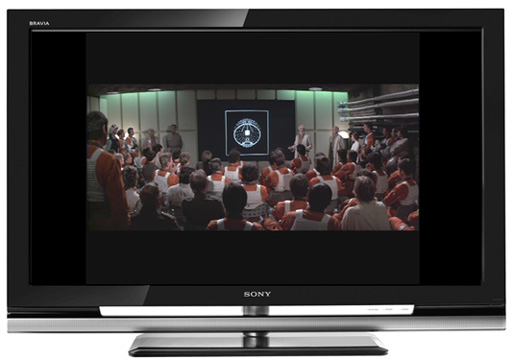
Not a very enjoyable way to watch the films, is it? It is very easy to convert this image to anamorphic so that it automatically fills a widescreen set; it pretty much costs nothing, and consumers can do this themselves using free software on the internet. But since this was not done, the only solution is to use your television's "zoom" function to blow up the image until it fills the frame. This is not the same as true anamorphic conversion, though, which re-scales the image so that it retains all its quality. Zooming your set also makes any subtitles get cut off, since they are displayed in the black bar area. Anamorphic enhancement has been the standard for home video for years, and pretty much every widescreen film is presented this way on DVD. Also, in case one is wondering--no, this does not count as "altering" the film. In fact, the letterboxing above is altering it, because those bars are not on the original film. Widescreen 35mm is actually itself anamorphic.
2) However, even were the image to fill your screen properly, this would simply highlight the most important issue of them all: it's a 1993 telecine. It will still look poor, because it was over a decade out of date when it was released in 2006 and now in 2010 is closing in at two decades out of date. There is a lack of fine detail, and the picture is a bit soft. This is simply because this was as state of the art as home video technology was at the time. Okay for 1993, but not acceptable in 2006. Laserdiscs did not display very much detail compared to DVD anyway, so it was not necessary to have any better picture quality than what we have here. As soon as you start displaying the image on larger screens, you can see how bad the picture is compared to modern transfers of films. This is the real flaw of the release. It was never meant to be seen in 2006.
3) Aside from that, however, another striking feature is the high level of film grain. This is especially apparent in the earlier reels of Star Wars. Why is this? Is it just because these are old movies and when not remastered and restored like the Special Edition this is how they look? A lot of people might be under this impression, but this is inaccurate. Star Wars should not look this grainy. Some even suspected that Lucasfilm added digital grain to make the films look worse, but I'm sure this isn't the case. The reason some would go as far as to make this accusation is because other releases, including the Laserdiscs that supposedly used this master, do not have grain like this. I have to admit, the situation here is slightly baffling. However, what I do know is that the films are not normally this grainy. One only need to look at the Senator Theatre's print. Take a look at those images, and you can see they are usually far less grainy than this transfer--and they've gone from negative, to interpositive, back to internegative, and then the print itself. The cap of Vader on the blockade runner looks downright clean. Other examples like the 70mm cell collection shows the same picture quality. No surprise since the film was shot on 100ASA fine-grain stock. The fact is, the negative that was used for the 1997 and 2004 Special Editions is the same negative used for this interpositive, and the original films should look similar in quality (the 2004 release had its grain dialed down, but you can see from raw negative scans that it is not this bad, and the 1997 release had no de-graining at all, so grain-wise it should have at least looked like that).
I do have some explanations. One is that the Laserdiscs themselves were softer, and so never displayed the full level of grain that is apparent on the masters themselves; the discs may have also been futher filtered in their pressings. Two is that the negatives at the time (in 1985 when the prints were struck, after all those theatrical re-releases) and the 1985 prints themselves were much dirtier than was apparent, again because the previous releases were a bit softer. When the negative was washed in 1995 for the restoration, it looked anew. However, one can distinguish dirt from grain here; dirt on both the negatives and prints makes the problem worse, but the problem is still already there. Given that the print was struck directly from the negative (in theory, that is what IPs are derived from; if this was derived from an internegative it would make more sense how grainy the image looks, but it would make no sense to do this), this means that most of the grain you see is on the interpositive print itself. Film stock from the 1980s was much grainier than what we are used to. However, 1985, the year these IPs were made, was a bit notorious. Kodak made a batch of stock that was so grainy they eventually recalled it with a new version in 1986. James Cameron shot Aliens on this stock, and was always unhappy with the grain--he is currently working on de-graining it for the impending HD release. Now, raw negative stock is totally different than duplicate stock, especially since the Aliens raw stock was a special low light stock (low light means more grain). I don't know if Kodak had similar issues with its duplicate stock, but it's a bit of a coincidence, for what it is worth.
In any case, the exessive grain here is on the IP duplicate, and it is a bit coarse by normal IP standards. The 2001 Directors Cut of Alien, for instance, was taken from an IP; while that IP was newly transferred, other IPs from the time look as they should, like the theatrical cut of Blade Runner from the 2007 release, which was sourced from the original IP. It has mild grain, as it should, with optical composites being much grainier, as it should, but overall is at least 50% cleaner looking that here. As it is sharper and from a new transfer, it shows finer detail than the GOUT, thus the GOUT would probably look even worse in this respect if taken from a better transfer. However, I must also point out that the GOUT is not quite as grainy looking as its reputation holds, except for the early reels of Star Wars and Empire, which were always dirtier than the rest of the films. The GOUT also has lots of video noise, being from a 1993 transfer, that makes the blemishing look slightly worse than it is.
4) Sadly, the list of grievences does not end there. Aside from the poor resolution of a 1993 master, this particular telecine was plagued with DVNR, or digital video noise reduction. This was done because, as noted, the source was grainy and dirty. However, DVNR, when it was introduced in the early 1990s, was notorious in home theatre circles when not used carefully, because it made the image look worse. In smoothing out the image, it erased detail, and more noticeably left trailing artifacts behind in its attempt to blend frames for a smoother image, so you have elements of the previous frame still visible in any moving object. Below is an example from Star Wars--the notorious four-eyed stormtrooper. As his head pops up into frame, detail from previous frames is left behind as he moves:
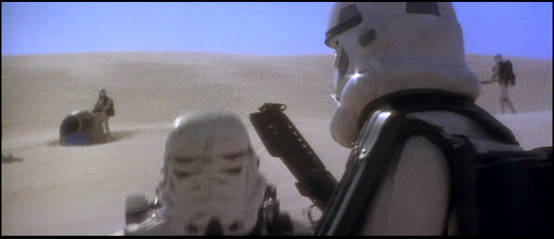
The detail in the sand has been smoothed away too. You can see this when you watch the film: the stationary camera that starts the shot has all the fine detail, and then as it pans left all the detail gets smeared away and leaves trails. A lot of the spaceship shots have this problem as well, and sometimes the stars leave trailing artifacts behind. Luke moving his head back and forth smears away his face as it blends the two frames:

And in the example below, the background players' legs and even parts of his whole body have become semi-invisible. Detail on the buildings and sand is also reduced. This shot was always grainier that the rest of the film, and so DVNR was applied more aggressively.
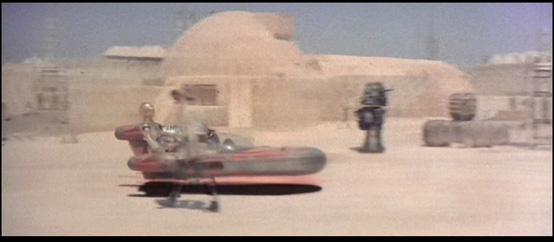
The following is the same frame from the Japanese Special Collection Laserdisc of 1986, which had no DVNR (and likely was from a different print too). You can see it is a bit grainier than the above, but you can see how much more detailed everything is. DVNR also eliminates some of the colour information; you can see how bland the 1993 master looks above, for example.
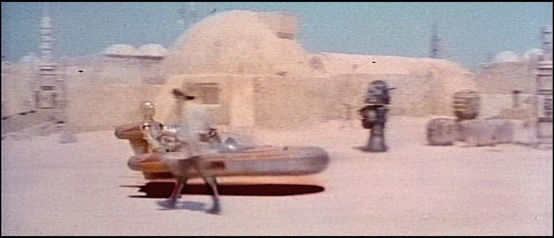
Empire and Jedi are affeced by this as well. For instance, below, the flying swamp creature behind Luke has left a trail of ghosts behind it from earlier frames (not very apparent in a still cap), as does the edge of Luke's hand rising up:
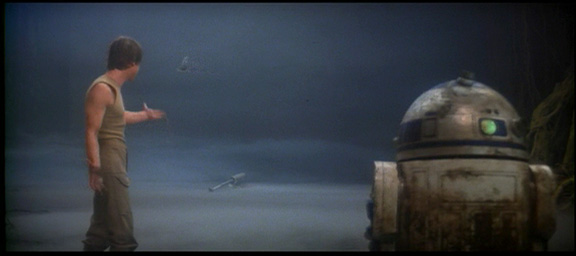
These are more obvious examples, but you can see in any moving shot detail smearing from the noise reduction. So, on top of being a 1993 transfer, the detail gets further reduced from DVNR.
5) The release also is plagued with another problem, which is gate weave, also sometimes called frame jitter. This means the image is subtly jittering left and right and up and down ever so slightly, because the film was not completely stable as it passed through the gate (probably because by 1993 the eight-year-old film was shrinking, or possibly just because the telecine machine did not have rock-solid gate registration). Today, this would be automatically corrected by a computer, stablizing the image, but such technology was not common in 1993.
6) Finally on the list of image problems, you have another artifact of the age of the telecine: aliasing. Sometimes you might see this referred to as "Laserdisc jaggies." This means that diagonal lines that are in motion show up as staircased blocks instead of smooth curves, much like on early pixelated video games. If you had a good LD player with a nice comb filter it might smooth some of this out, but it's simply the way the original tape master was recorded. Here is a more offending example from Star Wars (look at R2's blue dome bands, as he turns his head), but pretty much every shot has this to one degree or another:
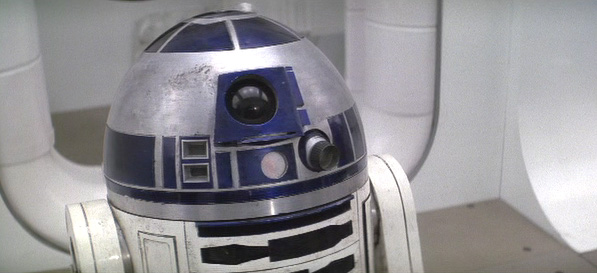
6) To top things off, the audio is not the authentic theatrical audio. Taken from the same 1993 master tape, it has added sound effects, most noticeable being the "broken glass" sounds during the cell block shootout. It also is compressed Dolby 2.0, whereas the Laserdiscs had uncompressed PCM sound for superior fidelity and dynamic range.
So, as you can see, complainers aren't just being picky. If you have any standard in your enjoyment of video, it's hard to not be peeved, especially when considering how anticipated and how important the release was. To use such an outdated and flawed video master when it hardly costs anything at all to make a new transfer, even if just as bonus features (with a proper restoration years down the road), shows such a huge level of disrespect for the films. For some fans, this was the straw that broke the camels back, that made them lose all faith and respect in Lucas--after waiting so long for a better release than Laserdisc, to throw such a shoddy effort to them seemed like a big middle finger to those who had supported him and built him into the success he is today.
When one considers that these were just released as "bonus features"--supplementary material for the main feature of the 2004 Special Edition--the low-quality seems understandable. These were never supposed to be a technical main feature--although you wouldn't know it by the marketing. But that's the problem. The most important three products Lucasfilm has in its library are relegated to supplementary videos as part of a nostalgia marketing milking.
Afterword: PAL--the European video standard--has slightly greater resolution than NTSC, the North American video standard, and the original PAL Laserdiscs were slightly sharper than their North American counterparts. Moth3r's PAL Laserdisc capture, as a matter of fact, displays slightly higher vertical resolution than the GOUT in certain shots, which makes me wonder if capturing an original PAL source using a souped-up custom LD player might be a better starting point for future fan restorations. However, the PAL versions of the 2006 DVDs were simply conversions from the NTSC master, rather than being original transfers as the original Laserdiscs were, so they are at a disadvantage rather than an advantage. In case anyone is wondering.